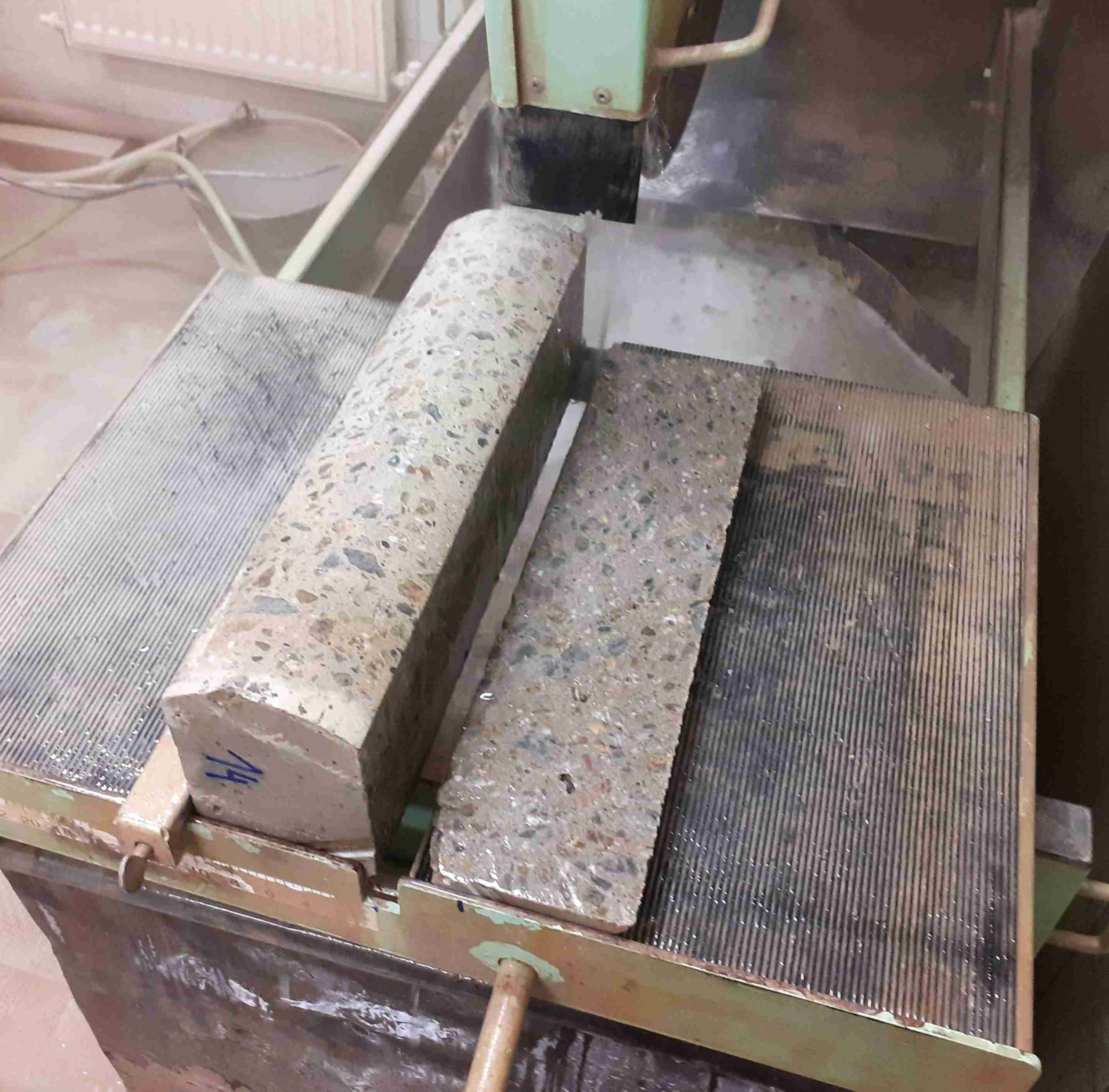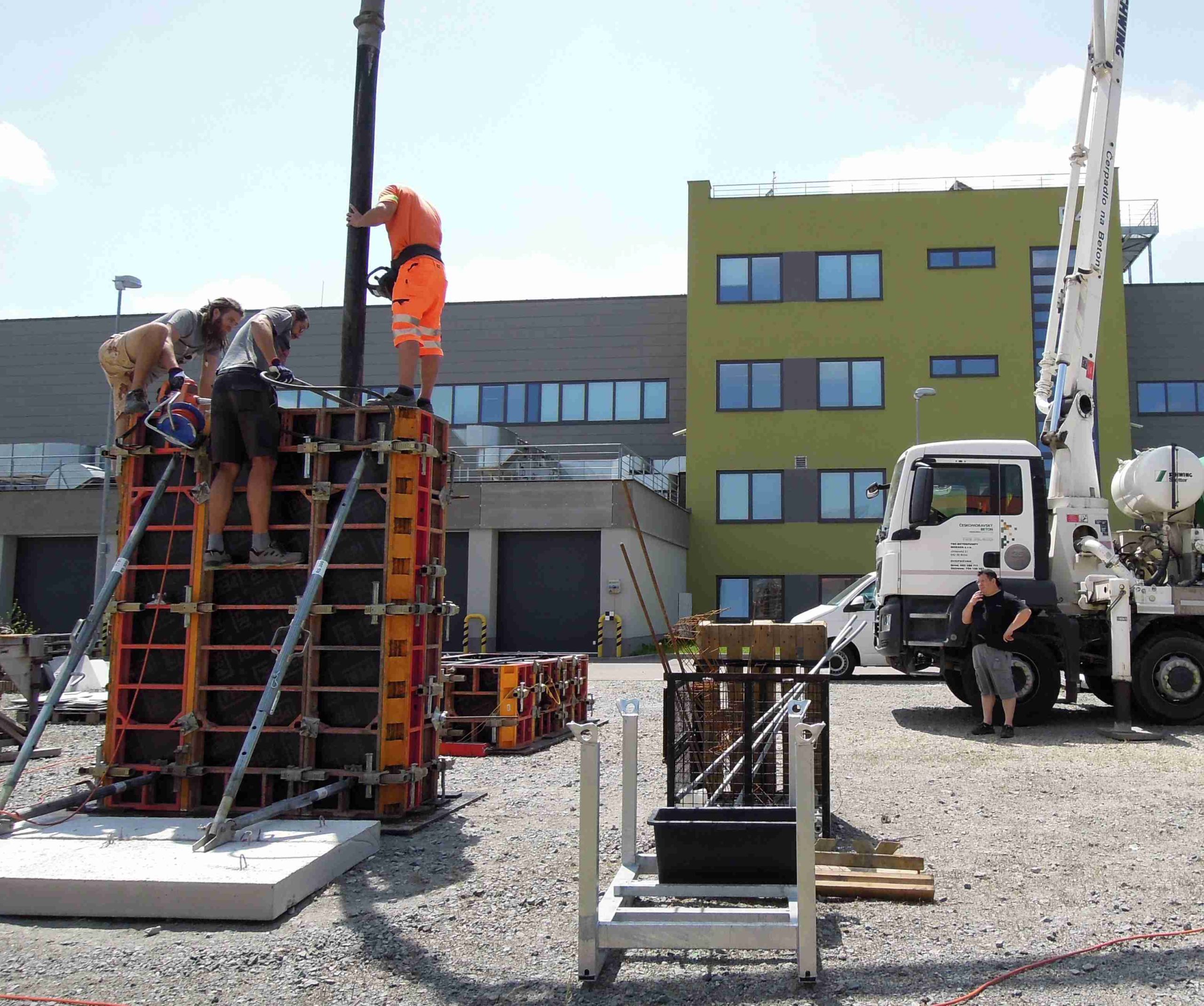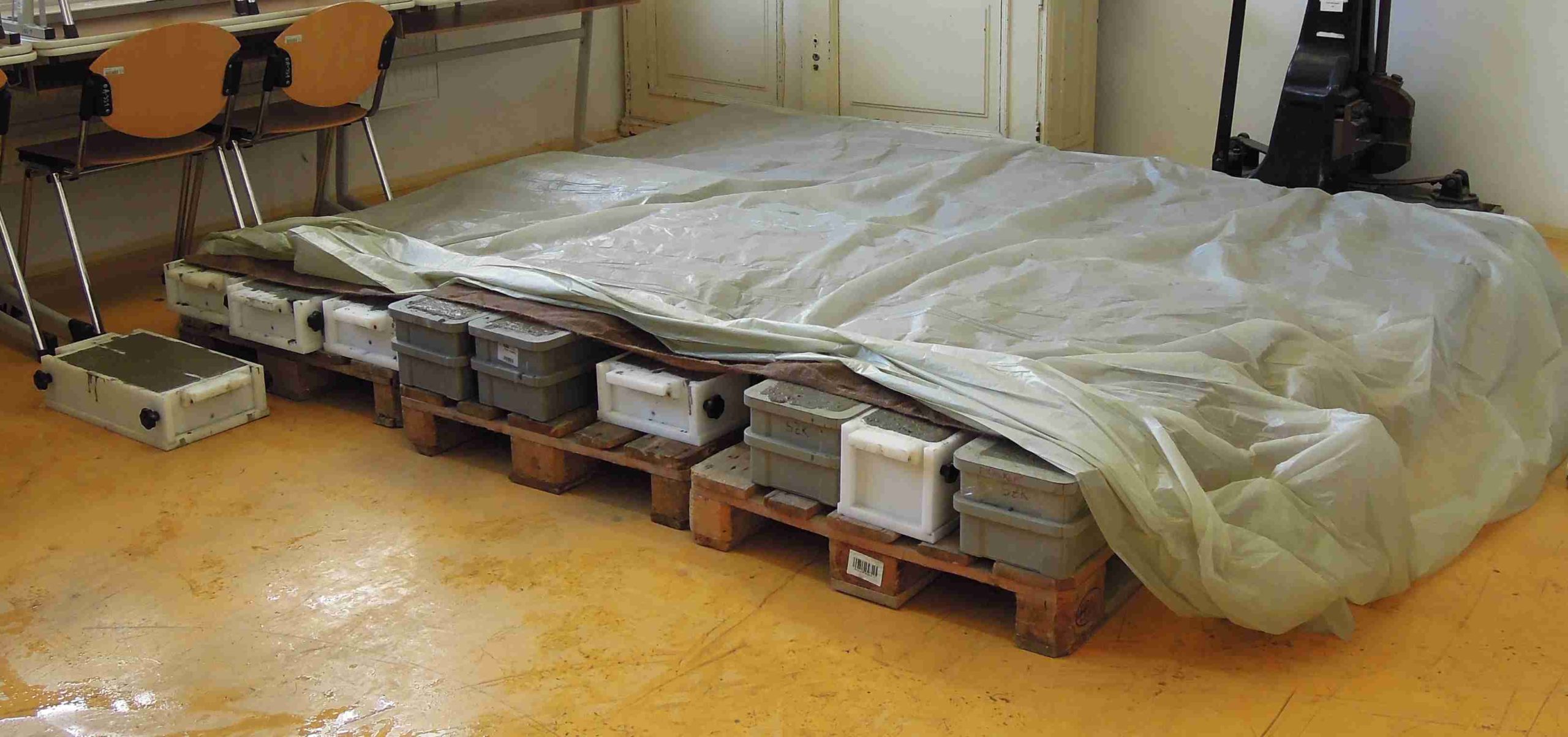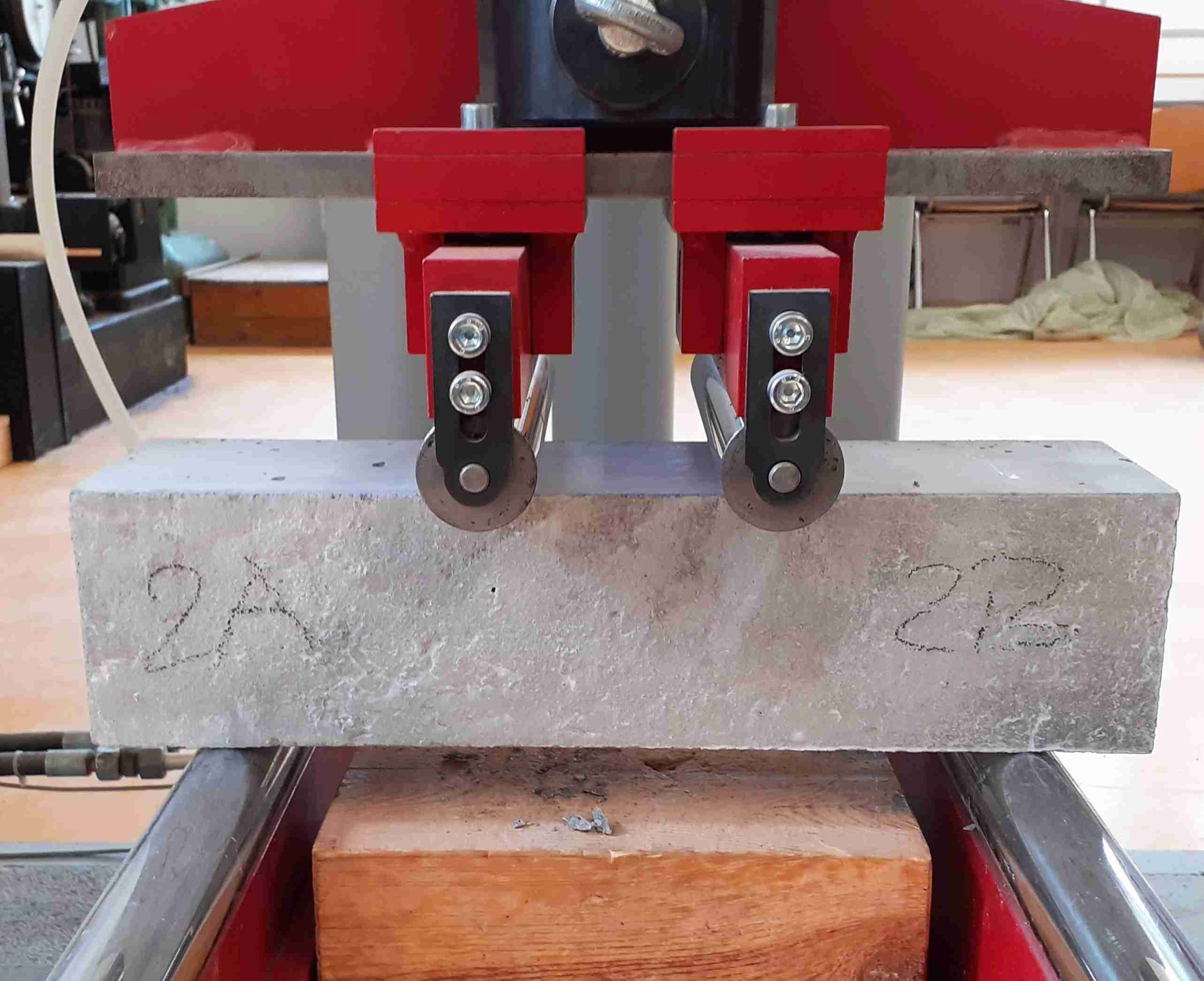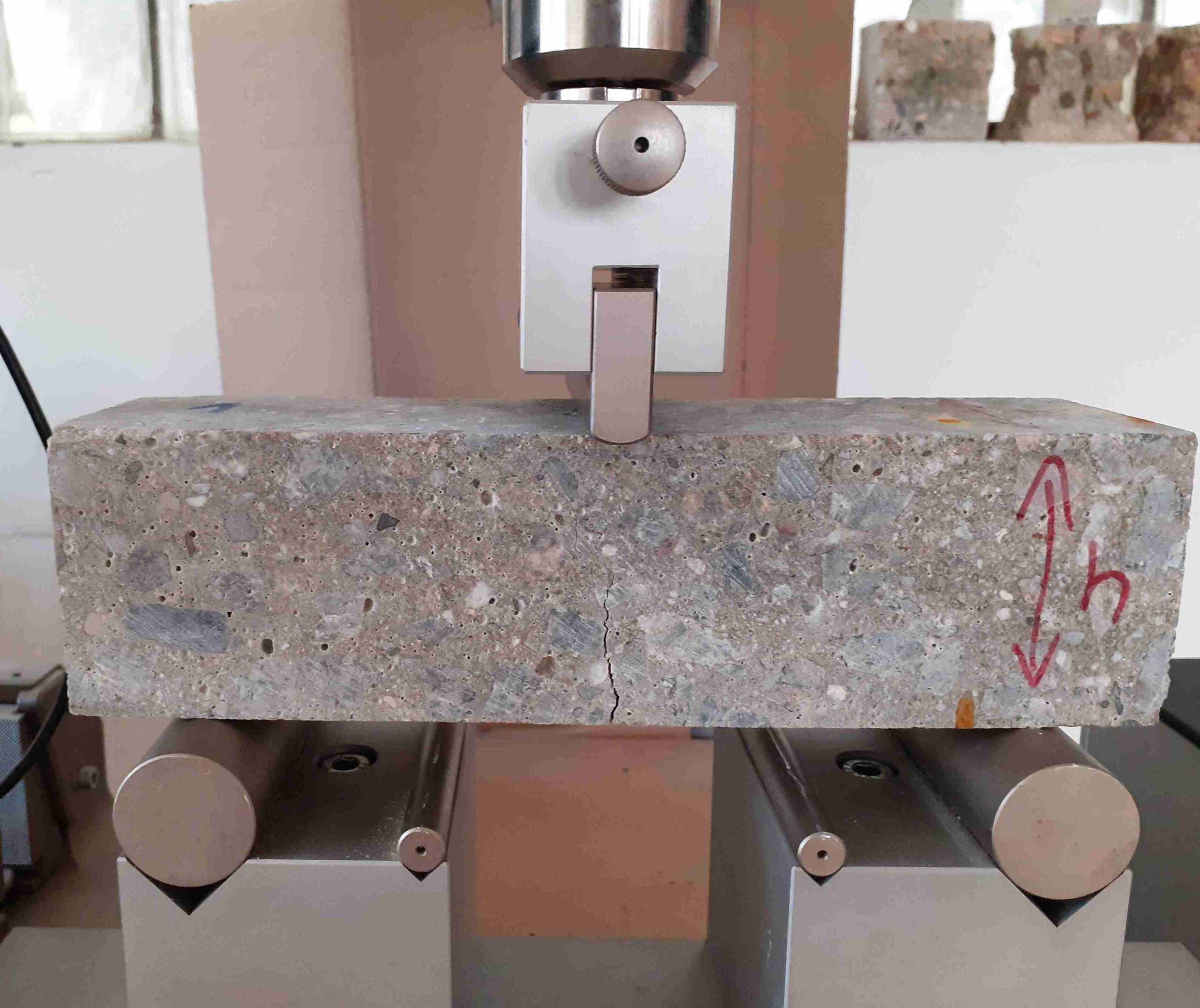Článek pojednává o využití alternativních zkušebních těles při zkoušce mrazuvzdornosti betonu. Důraz je kladen zejména na interpretaci a porovnání výsledků, které byly na různých zkušebních tělesech dosaženy. Pro potřeby experimentu byl vyroben větší betonový blok, který simuloval reálnou konstrukci. Z něj byly odebrány jádrové vývrty, z nichž bylo připraveno několik sad zkušebních těles. Současně s blokem bylo ze stejného betonu vyrobeno několik dalších sad zkušebních těles i v laboratoři. V závěru jsou kromě statistické analýzy výsledků nastíněny možnosti, jakým způsobem lze ke stanovení mrazuvzdornosti betonu v konstrukci přistupovat, a zároveň je shrnuto, jak je stanovení mrazuvzdornosti pomocí jádrových vývrtů ovlivněno.
,
Beton v konstrukci bývá mnohdy vystaven opakujícímu se střídání kladných a záporných teplot, kdy může docházet k jeho degradaci. Nutnou podmínkou degradace je však skutečnost, že je současně vystaven působení vysoké vlhkosti vzduchu či přímo působení vody, příp. dalších chemických látek nepříznivě působících na povrchovou vrstvu betonu (konstrukce). Na suchý beton, který se nachází v prostředí s nízkou vlhkostí vzduchu, nemá opakující se zmrazování a rozmrazování žádný výraznější negativní dopad [1]. Stanovit odolnost proti účinkům vrazu není u nově navrženého betonu problém – pro tento účel se vyrobí zkušební tělesa, na nichž se provede příslušná zkouška. Výsledkem je určení míry odolnosti betonu proti zmrazování a rozmrazování. Pokud je však nutné ověřit mrazuvzdornost u starších betonů zabudovaných v konstrukci (např. v případě její opravy nebo přestavby), nastává často poměrně značný problém – k dispozici z pochopitelných důvodů nejsou normou požadovaná zkušební tělesa, a proto je nutné více či méně improvizovat.
V případě konstrukcí či výrobků, kdy je beton v přímém kontaktu s vodou (kolejové pražce, silniční panely, vodní nádrže atd.), se vlivem nasákavosti betonu dostává voda do jeho pórové struktury. Dojde-li k jejímu zmrznutí, objevuje se riziko vzniku nejdříve mikrotrhlin a poté i trhlin v betonu. Příčinou poruch je expanze vody při změně z kapalného na pevné skupenství. Voda, která se nachází v kapilárních pórech betonu, se začíná měnit na ledovou tříšť přibližně při teplotě –0,5 °C, skutečný počátek mrznutí vody v betonu ovšem závisí na velikosti pórů, v nichž se voda nachází. Při teplotě –12 °C by však měla zmrznout veškerá kapilární voda [2]. Vzniklý led má oproti vodě v kapalném stavu objem větší přibližně o 9 %. Toto rozpínání vody ve formě ledu vede ke vzniku vnitřního napětí v betonu (velikost napětí může být řádově až desítky N/mm2). Výsledkem je porušení vnitřní struktury betonu a následné nevratné snížení jeho relevantních materiálových charakteristik [3].
Stanovení mrazuvzdornosti betonu
Stanovit mrazuvzdornost betonu je možné několika způsoby. Zásadním omezením je fakt, že se zkouška provádí téměř výhradně na zkušebních tělesech vyrobených ve formách. Výjimkou je americká norma ASTM C666 / C666M – 15 [4], která umožňuje zkoušet i jádrové vývrty či hranoly vyřezané ze ztvrdlého betonu. Má-li však výsledek vyhovovat evropským standardům, musí být zkoušeno těleso vyrobené laboratorně. Principem stanovení mrazuvzdornosti betonu je sledování vývoje hodnot předem zvolené materiálové vlastnosti, a to v závislosti na počtu provedených zmrazovacích a rozmrazovacích (dále též F‑T) cyklů za přítomnosti vody. Česká norma ČSN 73 1322 [5] pracuje primárně s pevností v tahu ohybem, což je logické – ve chvíli, kdy ve vnitřní struktuře betonu vzniknou trhliny nebo i mikrotrhliny, dojde okamžitě k poklesu pevnosti v tahu ohybem. Evropská norma CEN/TR 15177 [6] i norma [4] stanovují mrazuvzdornost betonu pomocí sledování změny jeho dynamického modulu pružnosti nebo změny délky těles. Zkoušky dynamických modulů pružnosti betonu jsou pro tento účel také vhodné, neboť jsou citlivé na změny v kvalitě jeho vnitřní struktury. Výsledkem je relativní dynamický modul pružnosti RDM.
Experiment
Základním cílem popisovaného experimentu bylo zjistit, jakým způsobem lze nejlépe (či nejsnáze) stanovit mrazuvzdornost betonu v konstrukci a současně se co nejméně odchýlit od postupu popsaného v normě ČSN 73 1322 [5]. V laboratoři byla vyrobena zkušební tělesa pomocí forem a také byly odebrány jádrové vývrty z betonového bloku umístěného ve venkovním prostředí, který byl zhotoven ve stejném čase a ze stejného betonu jako zkušební tělesa.
Zkušební tělesa
Pro potřeby experimentu byl na volném prostranství vyroben betonový blok s půdorysnými rozměry 1,8 × 0,45 m a s výškou 2,4 m, který představoval reálnou konstrukci. Poté byla ze stejného betonu v laboratoři vyrobena zkušební tělesa. Betonový blok byl po betonáži přikryt vlhkou tkaninou a PE fólií. Během prvních dvou dnů po betonáži byla tkanina kropena vodou. Blok byl ponechán v bednění přibližně jeden týden. Po odstranění bednění, včetně tkaniny a PE fólie, nebyl beton dále nijak ošetřován. Jádrové vývrty, z nichž byla připravena zkušební tělesa, byly odebrány přibližně dva měsíce po betonáži. Zkušební tělesa vyrobená pomocí forem byla po výrobě ponechána v laboratoři přikrytá vlhkou tkaninou a PE fólií.
Tato tělesa byla odformována po 48 hodinách a poté byla uložena do vodní lázně. Složení betonu je uvedeno v tab. 1.
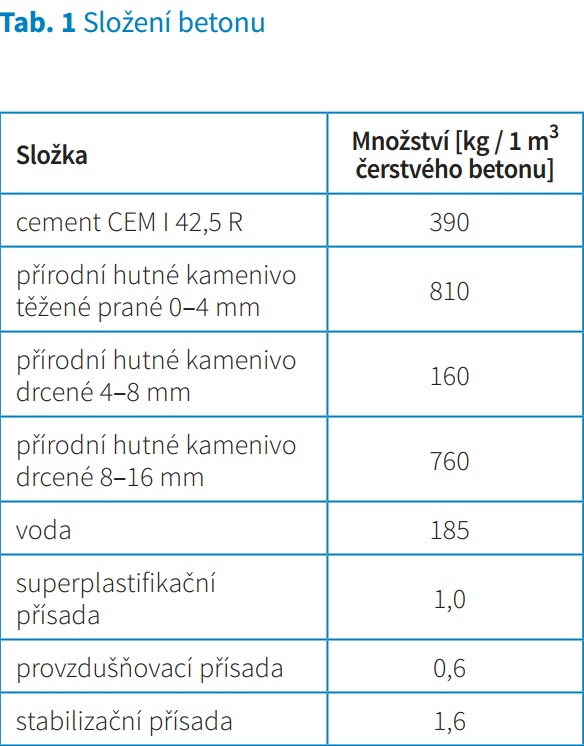
V tab. 2 jsou uvedeny základní vlastnosti betonu stanovené v čerstvém i ztvrdlém stavu ve stáří 28 dní.
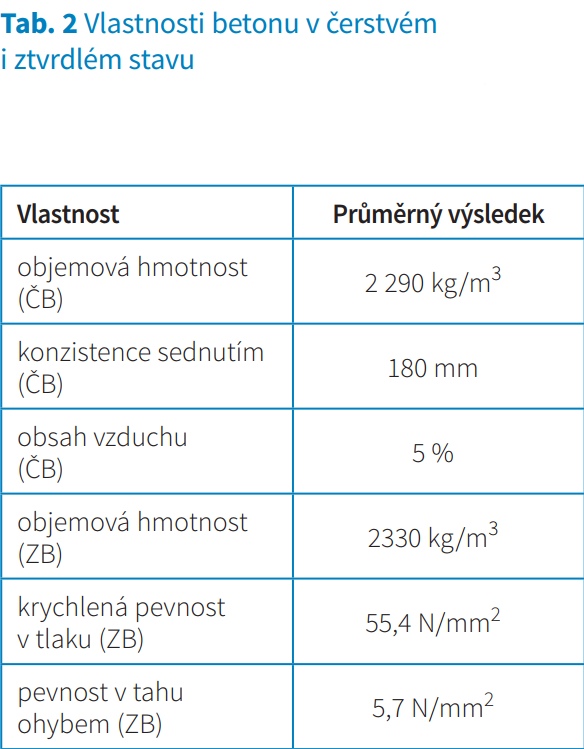
Pro samotné zkoušení mrazuvzdornosti bylo připraveno celkem šest sad po 9 ks zkušebních těles. První sadu tvořily hranoly 100 × 100 × 400 mm vyrobené pomocí forem – sada byla označena Ref. Druhá sada byla tvořena také hranoly 100 × 100 × 400 mm, ale tato tělesa byla vyřezána z hranolů 150 × 150 × 600 mm – tyto větší hranoly byly vyrobeny rovněž pomocí forem. Sada byla označena Řez-ref.
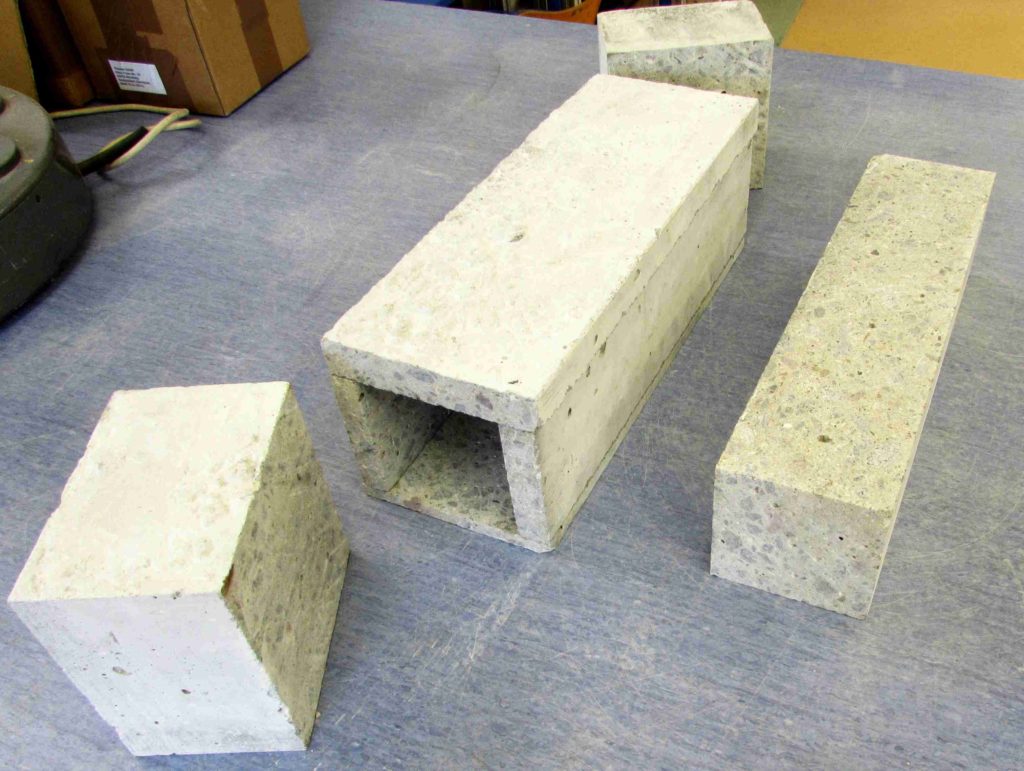
Další čtyři sady tvořila zkušební tělesa, která byla vyřezána z jádrových vývrtů. Třetí sadu tvořily hranoly 95 × 95 × 380 mm, které byly vyrobeny z jádrových vývrtů Ø 150 mm (obr. 6) – tato sada byla označena Řez95.
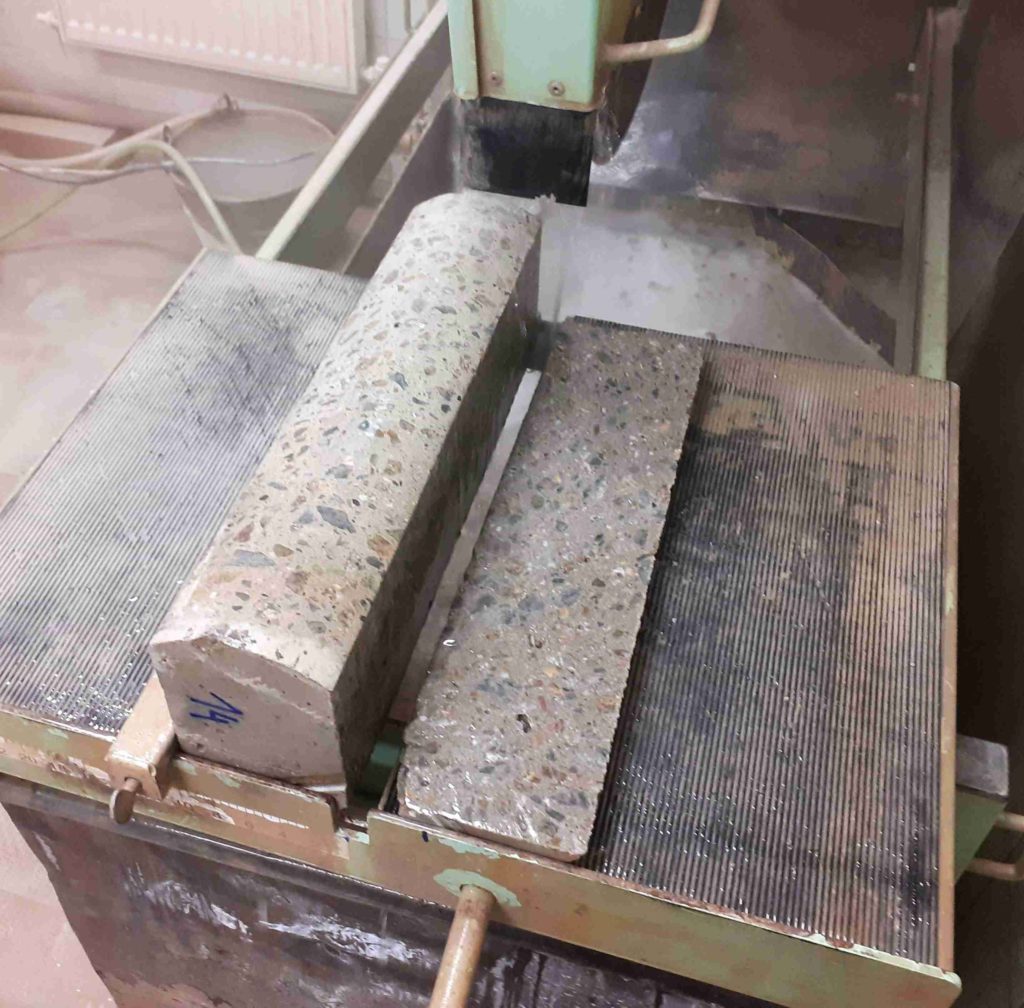
Čtvrtou sadu tvořily hranoly 65 × 65 × 240 mm, které byly vyrobeny z jádrových vývrtů Ø 100 mm (sada označena Řez65). Poslední dvě sady tvořily válce, které byly vyrobeny zaříznutím jádrových vývrtů. Pátá sada s označením JV100 byla tvořena válci Ø 100 mm a délky 400 mm a šestá sada s označením JV75 byla tvořena válci Ø 75 mm a délky 250 mm.
Postup zkoušení
Zkouška mrazuvzdornosti probíhala podle normy [5]. Proces zmrazování a rozmrazování byl podle [5] zvolen především z důvodu jednoduššího postupu, než jaký uvádějí ostatní podobné předpisy, např. [4], [6]. Pro zkoušku bylo použito automatické cyklovací zařízení KD 20. Sady zkušebních těles byly rozděleny na tři skupiny po třech tělesech. První skupina byla referenční, tato zkušební tělesa nebyla zmrazována. Ostatní zkušební tělesa byla podrobena požadovanému počtu 50 F‑T cyklů (3 ks těles), resp. 100 F‑T cyklů (3 ks těles). Po každém 25. cyklu byl prověřen stav zkušebních těles pomocí nedestruktivních metod. Zpět do zařízení KD 20 byla tělesa vložena jednak pootočena (kolem své podélné i příčné osy) a jednak byla situována na jiné místo, aby byl eliminován případný efekt proudění studeného vzduchu v komoře přístroje KD 20.
Jako hodnoticí kritérium byla v souladu s [5] zvolena změna průměrné pevnosti betonu v tahu ohybem. V každé sadě zkušebních těles byla stanovena pevnost v tahu na třech referenčních (nezmrazovaných) tělesech, na třech tělesech po 50 F‑T cyklech a na třech tělesech po 100 F‑T cyklech. Výsledkem je součinitel mrazuvzdornosti neboli relativní vyjádření pevnosti v tahu ohybem po daném počtu zmrazovacích a rozmrazovacích cyklů vůči „původní“ hodnotě pevnosti nezmrazovaného (tedy neporušeného) betonu.
Zkušební tělesa sad Ref, Řez-ref, Řez95 a JV100 byla zkoušena pomocí čtyřbodového ohybu, přičemž vzdálenost podpor byla vždy 300 mm a zatěžovací válečky byly umístěny ve třetinách rozpětí.
Zkušební tělesa sad Řez65 a JV75 byla zkoušena pomocí tříbodového ohybu, přičemž vzdálenost podpor byla vždy 180 mm a zatěžovací váleček byl umístěn v polovině rozpětí (obr. 9 a 10).
Výsledky a jejich diskuze
Výsledky provedených měření jsou uvedeny v tab. 3. U každé sady jsou uvedeny průměrné hodnoty zjištěné pevnosti v tahu ohybem tří nezmrazovaných těles, tří těles po 50 F‑T cyklech a tří těles po 100 F‑T cyklech.
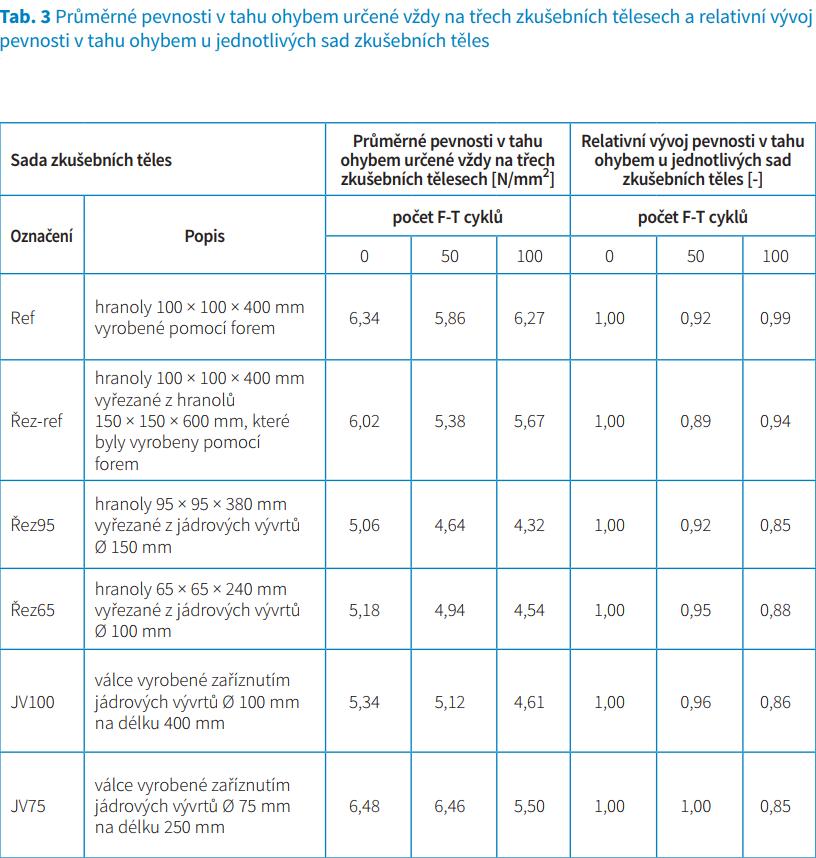
Ze stanovených průměrných hodnot pevností v tahu ohybem byl určen jejich relativní vývoj. Čím je hodnota po daném počtu F‑T cyklu nižší, tím je více poškozena vnitřní struktura betonu. Pokles pod hodnotu 0,75 podle [5] značí, že zkoušený beton není na daný počet zmrazovacích a rozmrazovacích cyklů mrazuvzdorný, což v tomto případě nenastalo.
Teoreticky by měly být všechny výsledky téměř shodné, neboť se u všech sad zkušebních těles jedná o tentýž beton. Přesto je ve výsledcích dobře patrný odlišný trend chování, a to především vzhledem ke způsobu získání zkušebních těles.
U těles vyrobených laboratorně pomocí forem lze pozorovat pokles pevnosti v tahu ohybem po 50 F‑T cyklech, ale opětovný nárůst pevnosti po 100 F‑T cyklech. Tento trend potvrzovaly i výsledky nedestruktivních zkoušek – k největšímu poklesu sledovaných vlastností došlo po 25 F‑T cyklech, ale v dalším průběhu docházelo k postupnému zlepšování betonu. Tento stav lze vysvětlit nasycením zkušebních těles ve chvíli začátku zmrazování. Voda v pórové struktuře betonu způsobila mikroporuchy hned během prvních F‑T cyklů, ovšem vzhledem ke kvalitě použitého (provzdušněného) betonu se vzniklé mikrotrhliny dále nerozvíjely. Naopak zde pravděpodobně došlo k tzv. samohojení betonu pomocí pokračující hydratace cementu. Pokud budou porovnávány výsledky hranolů přímo z formy a hranolů vyřezaných z větších těles z formy, horších výsledků zkoušky je dosaženo u vyřezaných těles. Zde se mohl negativně projevit vliv „otevřeného“ povrchu těles, tedy ploch řezů skrz strukturu betonu – rozdíly ovšem nejsou nijak zásadní.
U těles odebraných z betonového bloku, který představoval reálnou konstrukci, byl zaznamenán jiný trend vývoje relativní pevnosti betonu v tahu ohybem. U těchto těles docházelo k trvalému poklesu sledovaných vlastností. To může být způsobeno jiným stupněm nasycení těles v době zahájení zmrazování (zkušební tělesa z jádrových vývrtů byla uložena ve vodní lázni pouze tři dny před startem zkoušky), stejně jako jinými podmínkami zrání betonu. Pozitivním zjištěním je skutečnost, že všechny čtyři sady těles z bloku vykazují v podstatě stejné výsledky, a to bez ohledu na jejich tvar (hranol vs. válec) či způsob zkoušení (tříbodový vs. čtyřbodový ohyb). Na základě výsledků experimentu lze předpokládat, že v případě požadavku na ověření mrazuvzdornosti betonu ve stávající konstrukci by nebylo nutné odebírat vývrty velkých průměrů (150 až 200 mm), ale stačilo by odebrat vývrty Ø 75 mm a ohybovou zkoušku provádět přímo na nich. Pro potvrzení této predikce je však nutné provést podobný experiment na statisticky významnějším počtu vzorků i druhů betonů.
Také je na tomto místě vhodné poznamenat, že provzdušněný beton, u něhož se dobrá mrazuvzdornost předpokládala, byl pro experiment zvolen záměrně. Cílem bylo ověřit, zda se budou lišit výsledky dosažené na zkušebních tělesech z forem a výsledky získané z jádrových vývrtů. V rámci projektu ovšem autoři v experimentálních pracích pokračují i s neprovzdušněným betonem, u něhož se naopak vysoká mrazuvzdornost nepředpokládá. Výsledkem by mělo být zjištění, jaký typ zkušebního tělesa a uspořádání zkoušky vykáže nejvyšší „citlivost“, tedy v jakém případě bude dosaženo nejvýraznějšího poklesu sledované vlastnosti po F‑T cyklech.
Závěr
Na základě výsledků provedeného experimentu lze konstatovat, že výsledné hodnoty zkoušky mrazuvzdornosti betonu mohou být ovlivněny způsobem výroby zkušebních těles. Zkušební tělesa vyrobená pomocí forem dosahují lepších výsledků mrazuvzdornosti než tělesa odebraná z konstrukce, přestože se jedná o stejný beton.
Zkušební tělesa z konstrukce nelze připravit jinak než pomocí jádrového vrtání a kotoučového řezání, což s sebou nevyhnutelně nese riziko vzniku mikrotrhlin v betonu zkušebních těles. Navíc je povrch zkušebních těles tvořen řezem s obnaženým kamenivem. Tyto faktory, spolu s jiným způsobem zrání betonu v konstrukci než v laboratoři, mohou výsledek zkoušky mrazuvzdornosti negativně ovlivnit. Při hodnocení mrazuvzdornosti betonu ve stávající konstrukci je proto vhodné brát na tuto skutečnost zřetel.
Závěrem nezbývá než odborné veřejnosti navrhnout ke zvážení, zda by nebylo vhodné začlenit možnost zkoušet zkušební tělesa odebraná z konstrukcí i do českých předpisů, minimálně prostřednictvím technických pravidel ČBS, stejně jako tomu je v případě zmíněné ASTM. Tím by odborníci dali nám, prostým zkušebníkům a diagnostickým průzkumníkům, do rukou mocnou zbraň v boji za komplexnější a kvalitnější hodnocení stávajících konstrukcí.
Příspěvek vznikl za podpory projektu GAČR č. 19 – 22708S „Nové přístupy k predikci trvanlivosti provzdušněného betonu prostřednictvím zjišťování obsahu a rozložení vzduchových pórů a mrazuvzdornosti“.
Literatura
[1] COLLEPARDI, M. The New Concrete. 1. ed. Villorba, Treviso: Grafiche Tintoretto, 2006.
[2] AÏTCIN, P.-C. High-performance concrete. New York: E&FN Spon, 1998.
[3] SHANG, H.-S., YI, T.-H. Freeze-Thaw Durability of Air-Entrained Concrete. The Scientific World Journal. 2013.
[4] ASTM C666 / C666M – 15. Standard Test Method for Resistance of Concrete to Rapid Freezing and Thawing. West Conshohocken, PA, USA: ASTM International, 2015.
[5] ČSN 73 1322. Stanovení mrazuvzdornosti betonu. Praha: UHM, 1969.
[6] CEN/TR 15177. Testing the freeze-thaw resistance of concrete – Internal structural damage. Brussels: European Committee for Standardization, 2006.
